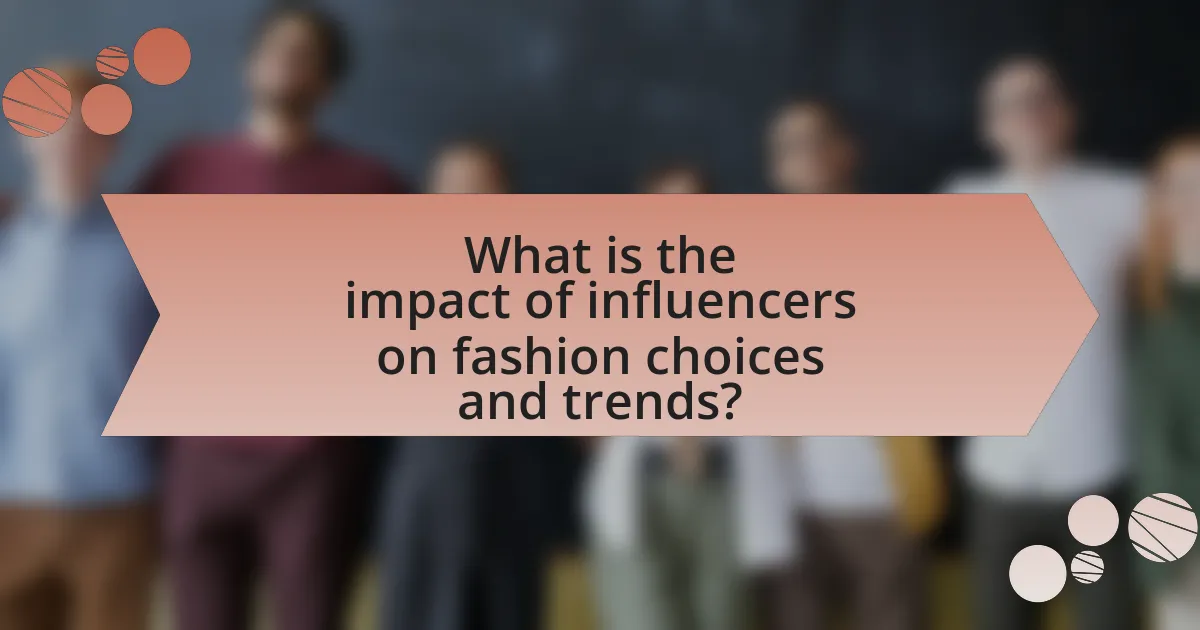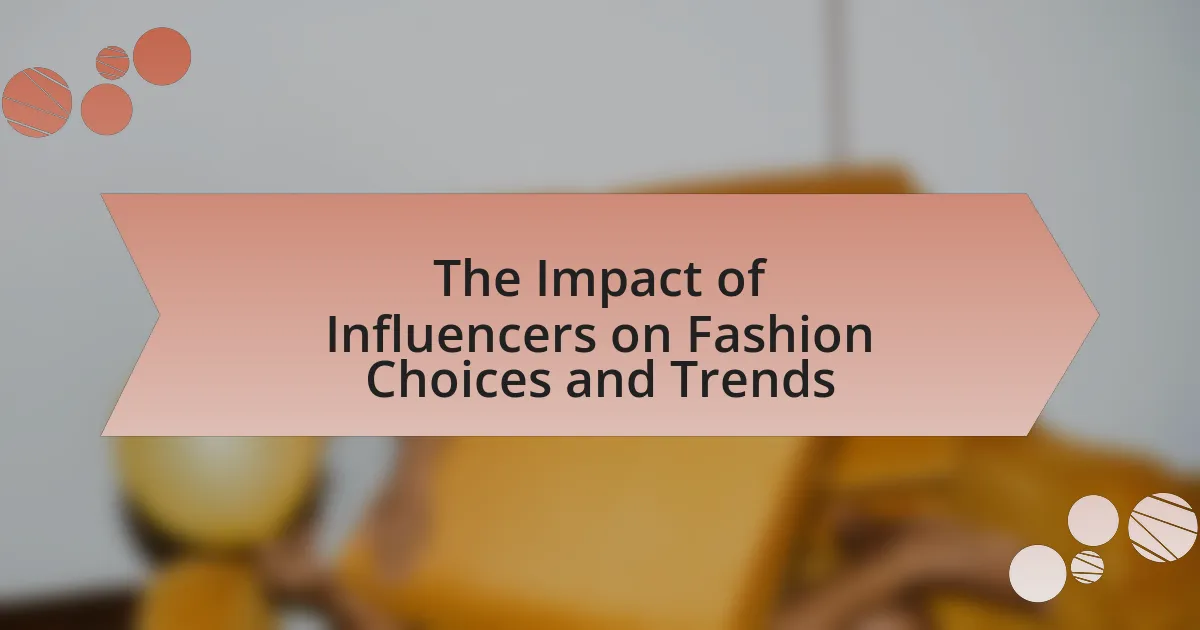The article examines the significant impact of influencers on fashion choices and trends, highlighting their role in shaping consumer behavior through social media platforms. It discusses how influencers create a sense of community, establish trust, and drive purchasing decisions, with research indicating that a substantial percentage of consumers rely on their recommendations. The article also explores the psychological factors influencing followers’ fashion choices, the different types of fashion influencers, and the implications of influencer marketing on sustainability and ethics in the fashion industry. Additionally, it addresses the challenges influencers face in promoting sustainable practices and offers practical tips for consumers to make informed fashion choices.

What is the impact of influencers on fashion choices and trends?
Influencers significantly shape fashion choices and trends by leveraging their social media platforms to promote specific styles and brands. Their ability to reach large audiences creates a direct impact on consumer behavior, as followers often emulate the fashion choices of influencers they admire. For instance, a study by the Fashion Institute of Technology found that 70% of consumers are influenced by social media when making fashion purchases, highlighting the persuasive power of influencers in driving trends. Additionally, influencers often collaborate with brands, leading to increased visibility and desirability of certain products, further solidifying their role in shaping contemporary fashion landscapes.
How do influencers shape consumer behavior in fashion?
Influencers shape consumer behavior in fashion by leveraging their social media platforms to promote brands and styles, significantly impacting purchasing decisions. Their ability to create aspirational content and establish personal connections with followers fosters trust, leading consumers to emulate their fashion choices. Research indicates that 49% of consumers depend on influencer recommendations for their purchasing decisions, highlighting the effectiveness of influencer marketing in driving sales and shaping trends.
What psychological factors influence followers’ fashion choices?
Psychological factors that influence followers’ fashion choices include social identity, conformity, and self-esteem. Social identity theory suggests that individuals choose fashion that aligns with their desired group affiliations, often influenced by the styles promoted by social media influencers. Conformity plays a significant role, as followers may adopt trends to fit in with peers or to gain social acceptance, reflecting the desire to belong to a particular social group. Additionally, self-esteem impacts fashion choices; individuals with higher self-esteem may opt for bold styles that express individuality, while those with lower self-esteem may gravitate towards more conventional or popular trends to avoid standing out. Research indicates that these psychological factors are critical in understanding how influencers shape followers’ fashion decisions, as they often leverage these dynamics to promote specific styles and brands effectively.
How do influencers create a sense of community around fashion trends?
Influencers create a sense of community around fashion trends by actively engaging their followers through interactive content, personalized communication, and shared experiences. They utilize social media platforms to foster discussions, encourage user-generated content, and host live events or Q&A sessions, which enhance follower participation and connection. For instance, a study by the University of Southern California found that influencers who respond to comments and share follower content significantly increase community engagement, leading to a stronger sense of belonging among followers. This engagement not only promotes fashion trends but also cultivates loyalty and a shared identity within the community.
Why are influencers considered trendsetters in the fashion industry?
Influencers are considered trendsetters in the fashion industry because they possess the ability to shape consumer preferences and drive trends through their extensive reach and engagement on social media platforms. Their large followings allow them to showcase new styles, brands, and products, often leading to viral trends that can significantly impact the fashion market. For instance, a study by the Digital Marketing Institute found that 49% of consumers depend on influencer recommendations when making purchasing decisions, highlighting their influence on consumer behavior. This dynamic establishes influencers as key players in determining what is fashionable and desirable in contemporary fashion.
What role do social media platforms play in influencer marketing?
Social media platforms serve as essential channels for influencer marketing by facilitating direct engagement between influencers and their audiences. These platforms, such as Instagram, TikTok, and YouTube, enable influencers to showcase products, share personal experiences, and create authentic content that resonates with followers. According to a 2021 survey by the Digital Marketing Institute, 49% of consumers rely on influencer recommendations when making purchasing decisions, highlighting the effectiveness of social media in driving consumer behavior. Additionally, social media algorithms enhance visibility, allowing influencers to reach larger audiences and brands to target specific demographics effectively.
How do influencers collaborate with fashion brands to set trends?
Influencers collaborate with fashion brands to set trends by leveraging their social media platforms to showcase products and create engaging content that resonates with their audience. This collaboration often involves sponsored posts, product placements, and exclusive partnerships, where influencers curate outfits or styles that highlight the brand’s offerings. For instance, a study by the Digital Marketing Institute found that 49% of consumers depend on influencer recommendations when making purchasing decisions, illustrating the significant impact influencers have on shaping consumer preferences and trends in the fashion industry.

What are the different types of fashion influencers?
There are several types of fashion influencers, including personal style bloggers, celebrity influencers, fashion stylists, and micro-influencers. Personal style bloggers create content showcasing their unique fashion choices, often influencing their followers’ styles through relatable and authentic posts. Celebrity influencers leverage their fame to promote fashion brands, significantly impacting trends due to their large audiences. Fashion stylists provide professional insights and recommendations, often collaborating with brands to shape public perception of fashion. Micro-influencers, who typically have smaller but highly engaged followings, can drive niche trends and foster community engagement around specific styles. Each type plays a distinct role in shaping fashion choices and trends in the industry.
How do micro-influencers differ from macro-influencers in fashion?
Micro-influencers differ from macro-influencers in fashion primarily in their audience size and engagement levels. Micro-influencers typically have between 1,000 to 100,000 followers, allowing for more niche targeting and higher engagement rates, often exceeding 7% per post, compared to macro-influencers, who have over 100,000 followers and generally experience lower engagement rates around 1-3%. This higher engagement from micro-influencers can lead to more authentic connections with their audience, resulting in greater trust and influence over fashion choices. Studies show that consumers are more likely to purchase products recommended by micro-influencers due to perceived authenticity and relatability, making them effective in shaping fashion trends.
What advantages do micro-influencers offer to fashion brands?
Micro-influencers offer fashion brands targeted engagement and authenticity, which enhances brand loyalty and consumer trust. Their smaller, niche audiences often result in higher engagement rates, with studies showing that micro-influencers can achieve engagement rates of 3.5% to 7%, compared to 1% for larger influencers. This level of interaction fosters a sense of community and connection, making followers more likely to act on recommendations. Additionally, micro-influencers typically have a more relatable image, which resonates with consumers seeking genuine endorsements, leading to increased conversion rates for fashion brands.
How do celebrity influencers impact fashion trends differently?
Celebrity influencers impact fashion trends differently by leveraging their personal brand and social media reach to create distinct styles that resonate with their audience. Unlike traditional fashion models, celebrity influencers often showcase relatable, everyday looks that their followers can emulate, leading to a more immediate and personal connection with fashion trends. For instance, a study by the Journal of Fashion Marketing and Management found that 70% of consumers are influenced by social media personalities when making fashion purchases, highlighting the significant role these influencers play in shaping consumer behavior. Additionally, celebrity influencers often collaborate with brands to create exclusive collections, which can drive trends by generating buzz and urgency among fans.
What categories of fashion influencers exist?
There are several categories of fashion influencers, including personal style bloggers, fashion vloggers, celebrity influencers, micro-influencers, and brand ambassadors. Personal style bloggers focus on sharing their individual fashion choices and outfits through written content and images, while fashion vloggers create video content showcasing their style and fashion tips. Celebrity influencers leverage their fame to promote fashion brands and trends, often collaborating with designers. Micro-influencers, who typically have smaller but highly engaged followings, often focus on niche markets and foster close connections with their audience. Brand ambassadors represent specific fashion brands, promoting their products through various platforms. Each category plays a distinct role in shaping fashion trends and consumer choices.
What defines a fashion blogger versus a fashion vlogger?
A fashion blogger is primarily a writer who shares fashion-related content through written articles and images on platforms like personal websites or social media, while a fashion vlogger creates video content focused on fashion, typically shared on platforms like YouTube or Instagram. The distinction lies in the medium: bloggers emphasize text and photography to convey their fashion insights, whereas vloggers utilize video to engage their audience with visual storytelling and dynamic presentations. This differentiation is significant in the influencer landscape, as it affects how audiences consume fashion content and interact with trends.
How do stylist influencers contribute to fashion choices?
Stylist influencers significantly shape fashion choices by curating trends and showcasing styles that resonate with their audience. They leverage social media platforms to present outfits, provide styling tips, and promote brands, effectively influencing consumer preferences. Research indicates that 49% of consumers rely on influencer recommendations for their purchasing decisions, highlighting the substantial impact these influencers have on shaping fashion trends and consumer behavior.

How do influencers affect fashion sustainability and ethics?
Influencers significantly impact fashion sustainability and ethics by promoting brands and practices that prioritize eco-friendly materials and ethical labor standards. Their large followings allow them to shape consumer perceptions and behaviors, often encouraging sustainable purchasing decisions. For instance, a study by the Fashion Institute of Technology found that 70% of consumers are more likely to buy from brands endorsed by influencers who advocate for sustainability. Additionally, influencers can raise awareness about unethical practices in the fashion industry, such as fast fashion’s environmental impact, thereby driving demand for more responsible alternatives.
What role do influencers play in promoting sustainable fashion choices?
Influencers play a crucial role in promoting sustainable fashion choices by leveraging their platforms to raise awareness and educate their followers about eco-friendly practices. They often showcase sustainable brands, highlight the importance of ethical consumption, and share personal stories that resonate with their audience, thereby encouraging a shift towards more responsible fashion habits. For instance, a study published in the Journal of Fashion Marketing and Management found that influencers significantly impact consumer attitudes towards sustainability, with 70% of respondents indicating they are more likely to purchase from brands endorsed by influencers who advocate for sustainable practices. This demonstrates that influencers not only shape trends but also drive meaningful change in consumer behavior towards sustainability in fashion.
How can influencers raise awareness about ethical fashion practices?
Influencers can raise awareness about ethical fashion practices by promoting sustainable brands and sharing informative content about the environmental and social impacts of the fashion industry. By collaborating with ethical fashion brands, influencers can showcase products that adhere to sustainable practices, thereby reaching their audience with credible alternatives to fast fashion. Research indicates that 66% of consumers are willing to pay more for sustainable brands, highlighting the potential influence of these endorsements. Additionally, influencers can utilize their platforms to educate followers on issues such as labor rights, waste reduction, and eco-friendly materials, fostering a more informed consumer base.
What challenges do influencers face in advocating for sustainability?
Influencers face several challenges in advocating for sustainability, primarily including audience skepticism, brand partnerships, and the complexity of sustainable practices. Audience skepticism arises as followers may doubt the authenticity of influencers’ commitment to sustainability, especially when their content often features fast fashion brands. Additionally, influencers often rely on brand partnerships for income, which can conflict with promoting sustainable products, as many brands prioritize profit over environmental responsibility. The complexity of sustainable practices also poses a challenge, as influencers may struggle to convey the nuances of sustainability effectively, leading to oversimplification or misinformation. These challenges hinder their ability to drive meaningful change in consumer behavior towards more sustainable fashion choices.
How do influencers impact the fashion supply chain?
Influencers significantly impact the fashion supply chain by driving consumer demand and shaping trends through their social media presence. Their endorsements and styling choices can lead to increased sales for specific brands and products, as evidenced by a 2021 study from the University of Southern California, which found that influencer marketing can yield an ROI of up to 11 times the initial investment. This influence prompts brands to adjust their production strategies, often leading to faster turnaround times and more responsive inventory management to meet the immediate preferences of consumers influenced by these personalities.
What changes in consumer demand have resulted from influencer marketing?
Influencer marketing has significantly shifted consumer demand towards authenticity and personalized experiences. Consumers increasingly prefer products endorsed by relatable influencers over traditional advertising, leading to a rise in demand for niche and unique fashion items. According to a 2021 survey by the Digital Marketing Institute, 49% of consumers rely on influencer recommendations for their purchasing decisions, indicating a strong correlation between influencer marketing and consumer behavior. This trend has resulted in brands adapting their strategies to focus on collaborations with influencers who resonate with their target audience, thereby enhancing engagement and driving sales.
How do influencers influence the production and distribution of fashion items?
Influencers significantly impact the production and distribution of fashion items by shaping consumer preferences and driving demand. Their ability to reach large audiences through social media platforms allows them to promote specific styles, brands, and trends, which in turn influences manufacturers to produce items that align with these trends. For instance, a study by the Fashion Institute of Technology found that 70% of consumers are more likely to purchase a product after seeing it endorsed by an influencer. This endorsement leads brands to adjust their production strategies to meet the anticipated demand, ensuring that they stock items that are likely to sell well. Additionally, influencers often collaborate with brands on exclusive collections, further directing the distribution channels to align with their followers’ interests.
What practical tips can consumers follow when influenced by fashion trends?
Consumers can follow several practical tips when influenced by fashion trends. First, they should assess their personal style and only adopt trends that align with their preferences and body types. This ensures that the clothing feels authentic and comfortable. Second, consumers should prioritize quality over quantity by investing in well-made pieces that will last longer, rather than fast fashion items that may quickly go out of style. Third, they can seek inspiration from multiple sources, including social media, fashion blogs, and magazines, to create a diverse wardrobe that reflects their individuality. Lastly, consumers should be mindful of their budget and avoid impulse purchases driven by fleeting trends, as this can lead to financial strain and clutter. By following these tips, consumers can navigate fashion trends effectively while maintaining their unique style and financial health.
How can consumers discern authentic fashion advice from influencers?
Consumers can discern authentic fashion advice from influencers by evaluating the influencer’s credibility, engagement with their audience, and transparency regarding partnerships. Credibility can be assessed through the influencer’s expertise, experience in the fashion industry, and consistency in style. Engagement metrics, such as comments and likes, indicate how well the audience resonates with the influencer’s advice. Transparency about sponsored content is crucial; influencers who clearly disclose partnerships are more likely to provide genuine recommendations. Research shows that 61% of consumers trust influencers who are transparent about their sponsorships, highlighting the importance of honesty in building trust.
What strategies can consumers use to make informed fashion choices?
Consumers can make informed fashion choices by researching brands, understanding fabric quality, and evaluating sustainability practices. Researching brands involves checking their reputation, customer reviews, and ethical standards, which helps consumers align their purchases with their values. Understanding fabric quality is crucial, as it affects durability and comfort; for instance, natural fibers like cotton and wool often outperform synthetic materials in breathability and longevity. Evaluating sustainability practices is increasingly important; according to a 2021 McKinsey report, 67% of consumers consider sustainability when making fashion purchases, indicating a shift towards environmentally conscious choices. By employing these strategies, consumers can navigate the fashion landscape more effectively and make choices that reflect their preferences and values.
